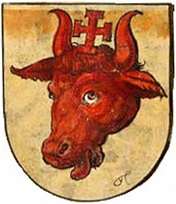Köten
| Köten | |
|---|---|
| Terter Khan | |
| Coat of arms |
 |
| Reign | 1223–1239 |
| Predecessor | ? |
| Successor | ? |
|
Issue
(see section) | |
| Noble family | Terteroba |
| Died |
1239 Pest, Hungary |
| Religion | Tengriism, Roman Catholicism (by conversion) |
| Occupation | Cuman khan |
Köten or Kotyan son of Sutoi[1] (variously Kutan, Kuthen, Kuthens, Kotyan, Kotjan, Koteny, Kötöny, Kuethan, or Zayhan) (fl. 1223–39) was a Cuman military commander and khan (lord) of the Terteroba clan during the mid–13th century. He later accepted Catholicism and was baptised as Jonas.
History
Rule
He forged the Cuman–Kievan Rus alliance against the Tatars. His son-in-law Mstislav the Bold, the Prince of Halych and Volhynia. Köten was allegedly of the Terteroba clan. He participated in the power struggles between the princes of Kyivan Rus' in 1202, 1225 and 1228. After the defeat by the Mongols in 1222, he convinced the princes of Kyivan Rus' to forge an alliance against the Mongols. He fought in the war against the Mongols (allied with the Russians) in the Battle of Kalka River, where the Rus-Cuman alliance was defeated.
Battle of the Kalka River
The Cuman–Kipchak confederation under Köten and a Rus army of 80,000 men under his son-in-law Mstislav the Bold fought a battle at the Kalka River (Kalchik, near Mariupol) against a Mongol contingent commanded by Jebe and Sübötäi. The Rus-Cuman army was routed and had to retreat (31 May 1223). Köten was deposed from power in that year, but he remained leader of the Terter tribe.
Mongol attacks
In the early spring of 1237, the Mongols attacked the Cuman-Kipchaks. Some of the Kuman-Kipchaks surrendered; it was this element that was later to form the ethnic and geographic basis of the Mongol khanate known to the former lords of the country as the "Kipchak khanate". Known also as the Golden Horde, the Kipchak khanate belonged to one of the branches of Jochi's house -Genghis Khan's eldest son. A Kipchak or Cuman chief named Batchman hid on the Volga banks, but was captured at a river island in the winter 1236-37; Möngke had him cut in half.
According to the evidence of Rashid-al-Din Hamadani, Berke led a third campaign in 1238 which inflicted final defeat on the Kumans-Kipchaks. It was then that the Kuman chief Köten emigrated with forty thousand "huts" to Hungary.
In 1238 he was again defeated by Batu Khan on the Astrakhan steppes.[1] Afterwards, Koten led 40,000 "huts" (families) (around 70 - 80,000 people) to Hungary (to escape from the Mongols), where he was later assassinated by the Hungarian and Germans in concert. The Cumans then left Hungary, pillaging along the way and emigrated to the Second Bulgarian Empire. Some of the Cumans were later called back to Hungary. He was possibly the most notable of Cumans (together with Baibars).
Stay in Hungary
At the start of Köten's reign the religion of the Kuman-Kipchaks was Tengriism. In 1238 Köten led his tribes into Hungary in flight from the advancing Mongol hordes. In return for their alliance and conversion to Roman Catholicism, Bela IV of Hungary granted them asylum. Köten was baptised in 1239 and his daughter Elizabeth married Bela's son, the future Stephen V of Hungary. The Hungarian nobles, however, distrusted the Cuman-Kipchaks (possibly thinking them to be spies for the Mongols) and just prior to the disastrous Mongol invasion which led to the rout of Mohi, they had Köten assassinated in Pest.
Aftermath
The enraged Kuman-Kipchak masses began to plunder the countryside, and moved southwards in the country. They crossed the Danube and reached Syrmia (called Marchia by Rogerius). After causing much destruction and havoc in Hungary, they left the country for Bulgaria.
According to Rogenus' description the Kuman-Kipchaks' last halt in Hungary was Syrmia, a territory between the Danube and the Sava, so the first Bulgarian territories they entered must have been Braničevo and Vidin. This supposition is in perfect agreement with our knowledge of the later history of these regions. The Bulgarian boyar families, the Shishmans in Vidin, Dormans in Braničevo, the Asen dynasty and Terter dynasty were of Cuman extraction, and must have settled in these regions after the large immigration of 1241. Köten's relatives and the leading figures of his royal clan settled in Bulgaria.
Family
- Maria who married Mstislav Mstislavich, who led uprising against Hungarians and became a ruler of the Galicia–Volhynia (r. 1220)
- A daughter who married Narjot III de Toucy (–1241). She became a nun after his death.
- Elizabeth the Cuman who married Stephen V of Hungary, King of Hungary
| Köten Terter clan Born: ? Died: 1239 | ||
| Preceded by ? |
Terter chief 1223–1228 |
Unknown |
Annotations
- Name: As rendered in the Russian annals, Russian: Котян Сутоевич/Kotyan Sutoevich; in Turkic: Köten; in Hungarian: Kötöny. And variously Kutan, Kuthen, Kuthens, Koteny, Kuethan, Zayhan, or Jonas.
See also
- Cumans
- Kipchaks
- George I of Bulgaria
- Dobrotitsa
- Shishmanids
- Asen dynasty
- Cumania
- Battle of Kalka River
- Mongol invasion of Rus'
References
- Павлов, Пламен (2005). ""Авантюристът-скит" Алдимир и Теодор Светослав". Бунтари и авантюристи в средновековна България (in Bulgarian). Варна: LiterNet.
- Rene Grousset, The Empire of the Steppes, 1970, Rutgers University Press
- Cumans and Tatars, Istvan Vasary, 2005, Cambridge University Press